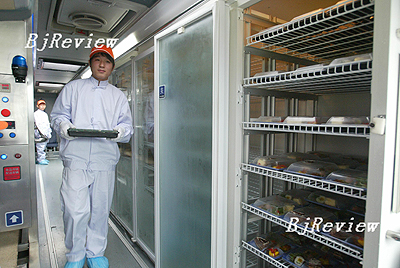
It's not only in the medal stakes that China hopes to impress the world at the 2008 Olympics. When the waves of visitors and athletes sit down to tuck into China's time-honored cuisine, the host country wants to leave no doubt as to who is the gold medal winner in the food stakes.
Cafeterias in the Olympic Village will ensure that 30 percent of their menus, or about 1,000 dishes, are Chinese, enough to please the fussiest of athletes and officials. Yet flavor and variety won't be the only thing Chinese chefs will be concerned about as they reach for the seasoning.
Any defective ingredient in these dishes, whether it be antibiotics-tainted shrimps or chemically dyed egg yolks, could cause athletes to fall ill or even fail an anti-doping test. A major outbreak of food-induced diseases may not only destroy athletes' four-year preparation for an Olympic medal, but also further tarnish China's food safety record.
To dismiss the possibility of such an accident and coordinate the logistics of feeding such big numbers requires enormous effort. Xinhua News Agency reports that more than 75,000 liters of milk, 330 tons of fruit and vegetables, 82 tons of seafood, 750 liters of ketchup, 131 tons of meat, 21 tons of cheese and 3 million bottles of beverages will be consumed by the 270,000 registered athletes, coaches, officials and journalists during the Beijing Olympics. And after organizers have paused for breath, there is also the small question of feeding an estimated 7 million meals to spectators.
At a press conference in July, the Chinese Government said that it has set up a rigorous food tracking and monitoring system for the 2008 Beijing Olympics, where the information for every cooking ingredient can be tracked to its source. According to a report on China News Service, detailed information has been collected on vegetable farms supplying Olympic food material, and entered into a database, including the name of the grower and the exact time and amount that the vegetable is given fertilizer and pesticide. To eliminate any contamination of the vegetables, organic pesticides and insect traps have been used to replace regular chemical pesticides. In addition, Beijing has also detailed a series of technical standards, covering the packaging, storing and transporting criteria of 345 foods.
All the information would be incorporated into a database, which would enable food supervisors to be fully aware of all the procedures and track the sources in case of any incidents, said Sun Wenxu, a senior official with the State Administration for Industry and Commerce at the conference.
"All the procedures involving Olympic food, including production, processing, packaging, storing and transporting, will be closely monitored," said Sun.
Importing expertise
This food information tracking system is largely developed using the Olympic expertise gained in Australia, especially New South Wales Food Authority, which was responsible for food security at the Sydney Olympics. As reported by The Beijing News, at a food safety agreement initiative between the Beijing Municipal Government and the New South Wales Food Authority in June, Australian Minister for State Development Ian Macdonald said the food tracking system is so advanced in New South Wales that a digital label recording the growing information is attached to every poultry and livestock product in supermarkets. He said this system has proved effective in pinpointing the origin of an epidemic. When Australia needed to find the origin farm of a mad cow disease outbreak, it took just one hour, while the same procedure took 10 days in the United States and two weeks in Canada.
Zhang Zhikuan, Director of the Food Safety Office of Beijing Municipal Government, said the food-tracking system will continue to be used after the Beijing Olympics. Pilot supermarkets in Beijing have already stocked shelves with food merchandise marked with production-tracking labels. The Beijing News says the food safety expertise learned from hosting the Olympic Games is expected to become standard and promoted around China.
Olympic meals on wheels
This July also witnessed the launch of Olympic food delivery vehicles for spectators and journalists who want a quick bite. The hi-tech cafeteria vehicles are equipped with a global positioning system, temperature monitoring system, video cameras in all directions, a freezer and a tunnel-designed microwave heater. The microwave heater and temperature monitoring system are being used in a vehicle for the first time in China. The equipment allows the vehicles to safely transport food at between zero and seven degree Celsius and disinfect food within two minutes. All the food on the vehicles is stored separately to avoid contamination.
|
